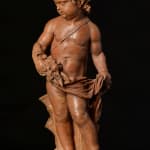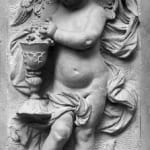
Artus Quellinus the Younger, Angel bearing a Chalice.
terracotta, height 59 cm
Royal Museum of Fine Arts of Brussels, inv. no. 2422.
Artus Quellinus the Younger (Sint-Truiden 1625 - Antwerp 1700)
Artus Quellinus the Younger was born in Sint-Truiden in 1625. His family counted many artists, sculptors as well as painters. His father, Erasmus Quellinus, was a painter, as were his brothers, Erasmus II and Hubertus. The young Artus was probably taught by his cousin, the famous baroque sculptor Artus I Quellinus (“the Elder”); he became a master of the Antwerp guild of St Luke in 1650/51. Between 1652 and 1654, he worked with his master Artus I on the decorations of Amsterdam’s city hall. Sometime afterwards he went to Italy, where he presumably visited Turin, Florence and Rome.
In 1663 he returned to Antwerp, where he became a citizen the same year. He married Anna Maria Gabron; the pair had six children. He taught several students, such as Thomas Quellinus, his son, and Alexander van Papenhoven; for several apprentices, however, it has not yet proved possible to determine whether they studied under him or his cousin, because the records don’t always specify which ‘Artus Quellinus’ is meant. After his return to Antwerp, the artist received many commissions in the Southern Netherlands; he primarily worked on church furnishings and decorations, as well as tomb sculptures. Works by Artus II Quellinus can still be seen in many important Flemish churches, such as St Paul’s Church and the Cathedral of Our Lady in Antwerp, St Salvator’s cathedral in Bruges and the Virga Jesse Basilica in Hasselt (in the latter, a tomb that originally stood in Herkenrode Abbey).
Stylistically, Artus Quellinus the Younger played an important role in the evolution of Flemish sculpture from high to late baroque. Initially influenced by his cousin, Artus I, who had worked in the workshop of François Duquesnoy, he later developed a more dramatic and expressive form, in the style of Gian Lorenzo Bernini and Lucas Faydherbe. This is reflected by his preference for graceful bodies, flowing drapery and tussled hair, as can be seen in the present work. With its many fine details, it is a testament to the impressive draughtsmanship of the artist.
Iconographically, a putto carrying an armful of produce and holding a shovel is most probably an allegory of the element earth, possibly forming part of a series of four (the other three works presumably having been lost or not yet rediscovered). It is known that Quellinus made at least one other series of allegorical works (the Four Seasons), as is evidenced by a pair of marble sculptures by his hand (Autumn and Summer, now kept in the Rijksmuseum) that are iconographically and stylistically very close to the present work. Interestingly, there is a terracotta relief in the Brussels Royal Museum of Fine Arts, also by Artus Quellinus the Younger, which is very close to the present work (inventory no. 2422; see fig. 1), especially in the treatment of the hair, face and drapery, and also in the strikingly similar positioning of the legs.
Provenance
French private collection.


